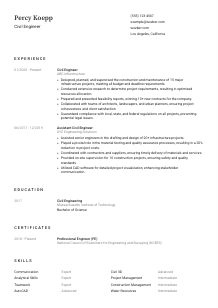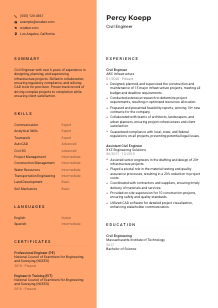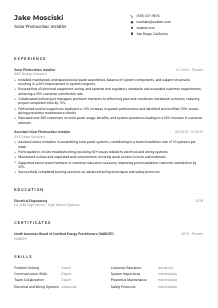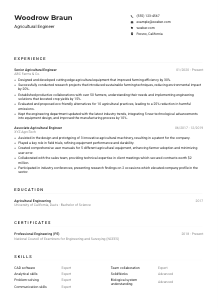Civil Engineer Resume Example
Laying foundations, but your resume feels shaky? Reinforce your credentials with this Civil Engineer resume example, structured using Wozber free resume builder. Dive into how you can align your infrastructural ingenuity with job requirements, paving the way for a career as solid as the structures you design.

How to write a Civil Engineer resume?
Greetings, aspiring Civil Engineer! If you're ready to build bridges to your future career and lay the foundations of success, let's construct a resume that not only stands strong against the competitive elements but also flawlessly aligns with the job requirements for a Civil Engineer role. With the Wozber free resume builder at our side, we'll delve into crafting a document that is both ATS-compliant and captivating to hiring managers. It's time to engineer your professional narrative with precision and passion, turning those job prospects from concept to reality.
Personal Details
Kickstarting your resume with an impeccably structured Personal Details section is like laying the groundwork for an impressive engineering project. It's the initial survey that guides the entire construction process. Here, we'll show you how to ensure this section is not just informative but strategically aligned with the Civil Engineer position you're aiming for.
1. Your Name as Your Brand
Think of your name as the masthead of a well-known engineering firm. It should be prominently displayed, using a clear, professional font. This is the cornerstone of your personal brand, and it should command attention.
2. Job Title Precision
Right below your name, position the title "Civil Engineer" to echo the job you're pursuing. This immediate alignment with the job description tells the hiring manager that your resume is crafted with their needs in mind.
3. Essential Contact Info
Streamline your contact information to include your phone number and a professional email format, preferably firstname.lastname@email.com. This ensures you're easily reachable for that interview call.
4. Location Relevance
Since the job specifies "Los Angeles, California", including this in your details matches one of the key requirements, showcasing your readiness and eligibility for the position without any relocation delays.
5. Professional Online Presence
If you have a LinkedIn profile or a portfolio site displaying your projects, include it. This gives hiring managers a portal to dive deeper into your professional world, but ensure it's mirror-polished and reflects your resume.
Takeaway
Your Personal Details section is the foundation upon which the rest of your resume is built. By aligning it perfectly with the job requirements, you make a powerful first impression. It's your initial moment to shine and ensure every detail resonates with your future role as a Civil Engineer.





Experience
The Experience section of your resume is where the rubber meets the road. It's your chance to showcase the engineering projects you've steered, the challenges you've navigated, and the results you've delivered. Let's craft it with the precision of a finely tuned CAD drawing.
- Designed, planned, and supervised the construction and maintenance of 15 major infrastructure projects, meeting all budget and deadline requirements.
- Conducted extensive research to determine project requirements, resulting in optimized resources allocation.
- Prepared and presented feasibility reports, winning 10+ new contracts for the company.
- Collaborated with teams of architects, landscapers, and urban planners, ensuring project cohesiveness and client satisfaction.
- Guaranteed compliance with local, state, and federal regulations on all projects, preventing potential legal issues.
- Assisted senior engineers in the drafting and design of 20+ infrastructure projects.
- Played a pivotal role in the material testing and quality assurance processes, resulting in a 20% reduction in project costs.
- Coordinated with contractors and suppliers, ensuring timely delivery of materials and services.
- Provided on‑site supervision for 10 construction projects, ensuring safety and quality standards.
- Utilized CAD software for detailed project visualization, enhancing stakeholder communication.
1. Highlighting Civil Engineering Projects
Start by reflecting on your project history, especially those that align with the job description's mention of infrastructure projects. Your role in designing, planning, and supervising such projects is your main highlight here.
2. Structuring Your Contributions
Organize your experience in reverse chronological order, beginning with your most recent position. Detail your job title, the company, and the duration you spent there, ensuring the layout is as clean and precise as an engineer's blueprint.
3. Achievements That Resonate
"Designed, planned, and supervised the construction of 15 major infrastructure projects," for instance, directly mirrors the job's call for someone capable of overseeing infrastructure projects. Tailor each bullet point to reflect such relevant accomplishments.
4. The Power of Quantification
Numbers speak volumes. Maybe you saved the project budget by 20% or enhanced project timelines. Such quantifiable achievements offer tangible proof of your engineering prowess and your capacity to add value.
5. Relevance Over Quantity
While you might be tempted to list every project you've ever worked on, keep the focus on those most relevant to the Civil Engineer role you're applying for. Precision and relevance trump volume every time in this section.
Takeaway
Your experience as a Civil Engineer is a testament to your capabilities. By strategically selecting and presenting your professional history, you make a compelling case for why you're the perfect fit for the job. Tailor each achievement to showcase how you meet and exceed the job requirements, and you'll be on your way to securing your next role.
Education
Your Education section is more than a list of institutions; it's a reflection of your journey and the hard-earned knowledge that has equipped you to take on the challenges of a Civil Engineer. Let's construct this section to highlight your academic credentials effectively.
1. Addressing the Fundamental Requirement
The job calls for a "Bachelor's degree in Civil Engineering." Ensure your degree is prominently listed, mirroring the requirement directly. This establishes your primary qualification right off the bat.
2. A Clean, Structured Presentation
Organize your educational background with clarity and simplicity. List your degree, the issuing institution, and the graduation year. This straightforward structure ensures easy navigation and comprehension.
3. Degree Specifics Matter
Listing your "Bachelor of Science in Civil Engineering" precisely matches the job's education requirement, solidifying your candidacy. For roles as specific as Civil Engineering, matching the degree title exactly can be crucial.
4. Coursework That Complements
While our example resume didn't require it, mentioning relevant coursework or projects can be particularly advantageous, especially when they underscore skills or knowledge directly applicable to the job at hand.
5. Beyond the Classroom
Any honors, relevant extracurricular activities, or project work that demonstrates your passion and commitment to the field of Civil Engineering can be a notable addition, providing a more rounded view of your qualifications.
Takeaway
Your academic background in Civil Engineering lays the foundational knowledge necessary for building a successful career. Highlighting this section according to the job requirements underscores your readiness and fit for the role. It's about showcasing not just that you learned, but what you've prepared yourself to do with that knowledge.
Certificates
In the evolving field of Civil Engineering, staying ahead with certifications can significantly bolster your credentials. Let's navigate how to present your certifications in a way that they underscore your commitment to professional development and match the job's preferences.
1. Aligning with Job Preferences
The preferred "Professional Engineer (PE) license" should take precedence if you possess it. Highlighting such certifications matches the job specifications and shows you have sought-after qualifications in the field.
2. Curating Your Certifications
Choose to list those certifications that are most relevant to the role. This isn't the place for all your achievements - focus on the ones that directly amplify your suitability for the Civil Engineer position.
3. Dates Make a Difference
Including the validity dates of your certifications, especially if they're current, adds credibility to your resume. It shows your knowledge is up-to-date, a vital trait in the fast-paced engineering world.
4. Continual Learning
The engineering sector's constant evolution means that ongoing education is not just beneficial but necessary. Regularly updating your certifications and seeking out new learning opportunities showcase a dedication to your professional growth.
Takeaway
Certifications are like the advanced tools in an engineer's toolkit, showcasing specialized skills and a commitment to staying at the forefront of the field. Selectively include those certifications that bolster your application, demonstrating that you are not just qualified but also continuously advancing in your career.
Skills
As a Civil Engineer, your skills inventory is a blend of technical prowess and soft skills that enable successful project delivery. Let's align your skills section with the job's demands, ensuring this segment of your resume is as thoughtfully engineered as any of your projects.
1. Extracting from the Job Description
Begin by identifying both the explicitly stated and the subtly implied skills in the job listing. Skills such as proficiency in "CAD software" and "strong communication" are your starting point.
2. Matching Your Skillset
Reflect on your own skillset and align it with the job's requirements. For CAD proficiency, list your experience with "AutoCAD" and "Civil 3D" to match the job description's call for CAD software skills.
3. Organized and Focused
Resist the temptation to list every skill you possess. Focus on the ones that matter most for this job. An ATS-friendly resume format is not just about passing a scan but also ensuring the hiring manager sees your most relevant skills first.
Takeaway
Your skills section is a compact showcase of your professional capabilities. Precisely align it with the job requirements, highlighting both your technical and soft skills. This is where you convey your proficiency and readiness for the challenges of the Civil Engineer role, all while passing the scrutiny of any ATS resume scanner.
Languages
In our interconnected world, the ability to communicate across cultures is invaluable, even in fields like Civil Engineering where the focus might seem purely technical. Here's how you can leverage your multilingual abilities to stand out.
1. Matching Job Requirements
"English language efficiency" is underscored in the job description. If English is your strong suit, place it at the top of your languages list, labeling your proficiency clearly.
2. Highlight Additional Languages
Adding languages besides English can set you apart, especially in a city as diverse as Los Angeles. If you possess proficiency in any additional languages, list them to showcase your capacity for broader communication.
3. Clear Proficiency Indicators
Be straightforward about your language proficiency levels, whether it's "Native," "Fluent," "Intermediate," or "Basic." This clarity provides a better understanding of your communication capabilities.
4. The Global Engineer
For a role within a multicultural city or on projects with international partners, your language skills can be a significant advantage, portraying you as a cosmopolitan professional ready to engage in a global setting.
5. Continuous Improvement
Languages are dynamic, just like the field of Civil Engineering. Showcasing a commitment to improving your language skills can be indicative of your overall approach to personal and professional growth.
Takeaway
Your linguistic skills reflect an ability to navigate diverse environments and communicate effectively in a range of scenarios. Highlighting your languages showcases not just your communication skills but also a readiness for the global aspects of modern engineering tasks. Embrace your multilingual talents as part of your professional identity.
Summary
The Summary section is where you frame your professional narrative, setting the stage for the detailed achievements that follow. It's about distilling your experiences, skills, and ambitions into a concise introduction that encapsulates your suitability for the Civil Engineer role.
1. Digesting the Job Description
Begin by absorbing the essence of the job listing. Understand what's asked of the prospective Civil Engineer - from designing infrastructure projects to ensuring regulatory compliance.
2. Crafting Your Opening Statement
Use your opening lines to introduce yourself as a dedicated Civil Engineer with a blend of experience and skill that perfectly matches the job's requirements.
3. Highlighting Achievements and Skills
Mention specific skills like "proficiency with CAD software" and achievements such as "designed, planned, and supervised the construction of 15 major infrastructure projects," aligning directly with the job description.
4. Brevity is Key
Keep your summary crisp and compelling. Think of it as your elevator pitch; it should be potent enough to engage the reader and make them eager to dive deeper into your resume.
Takeaway
Your Summary is the first impression you make – a brief showcase of your engineering expertise and professional identity. Tailoring it to echo the job's requirements immediately identifies you as a serious and relevant candidate. Remember, your story is unique, and this is where you start telling it.
Launching Your Civil Engineer Journey
With the blueprint in hand, you're now ready to construct a resume that not only navigates the ATS with ease but also engages and impresses hiring managers. Your aspiration to become a Civil Engineer, reflected through a meticulously tailored resume, is the gateway to your next career milestone. The Wozber free resume builder, equipped with ATS-friendly resume templates and an ATS resume scanner, is your companion in this journey. Use this guide and Wozber's dedicated tools for resume targeting as your foundation, and let your skills, experience, and passion do the rest.
The path from blueprint to skyscraper begins with a single step – your resume. Let's build a future as impressive as the structures you're inspired to create.

- Bachelor's degree in Civil Engineering or related field.
- Professional Engineer (PE) license is preferred.
- Minimum of 5 years of experience in civil engineering projects.
- Proficiency with CAD software such as AutoCAD or Civil 3D.
- Strong communication, analytical, and project management skills.
- English language efficiency is a requirement.
- Must be located in or willing to relocate to Los Angeles, California.
- Design, plan, and supervise construction and maintenance of infrastructure projects.
- Conduct research to determine project requirements and standards.
- Prepare and present feasibility reports and design proposals to clients.
- Collaborate with multidisciplinary teams of architects, landscapers, and urban planners.
- Ensure compliance with local, state, and federal regulations and building codes.















